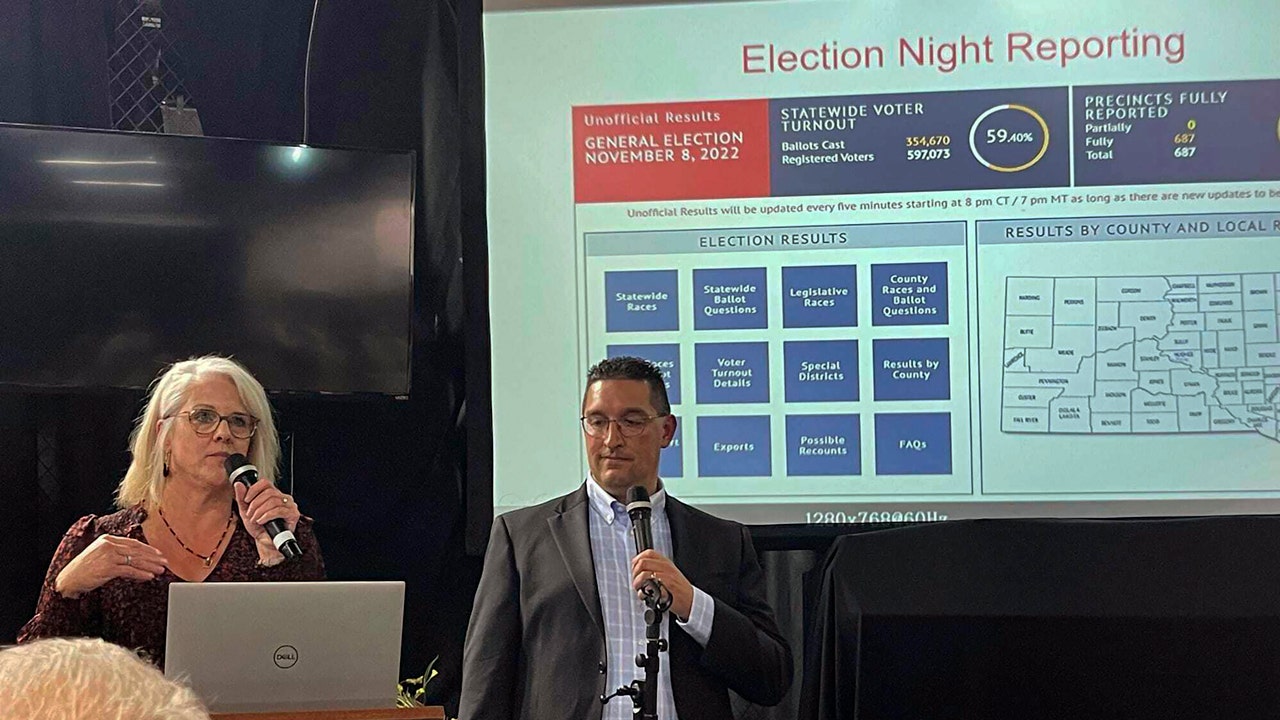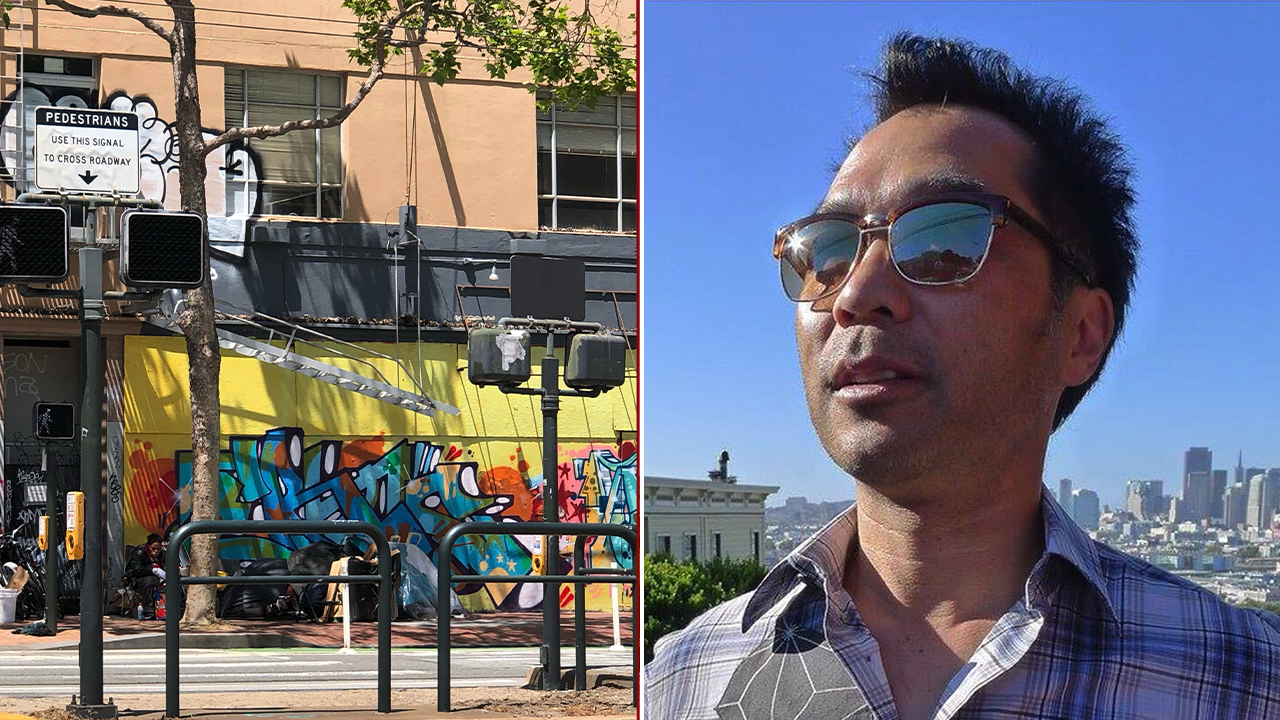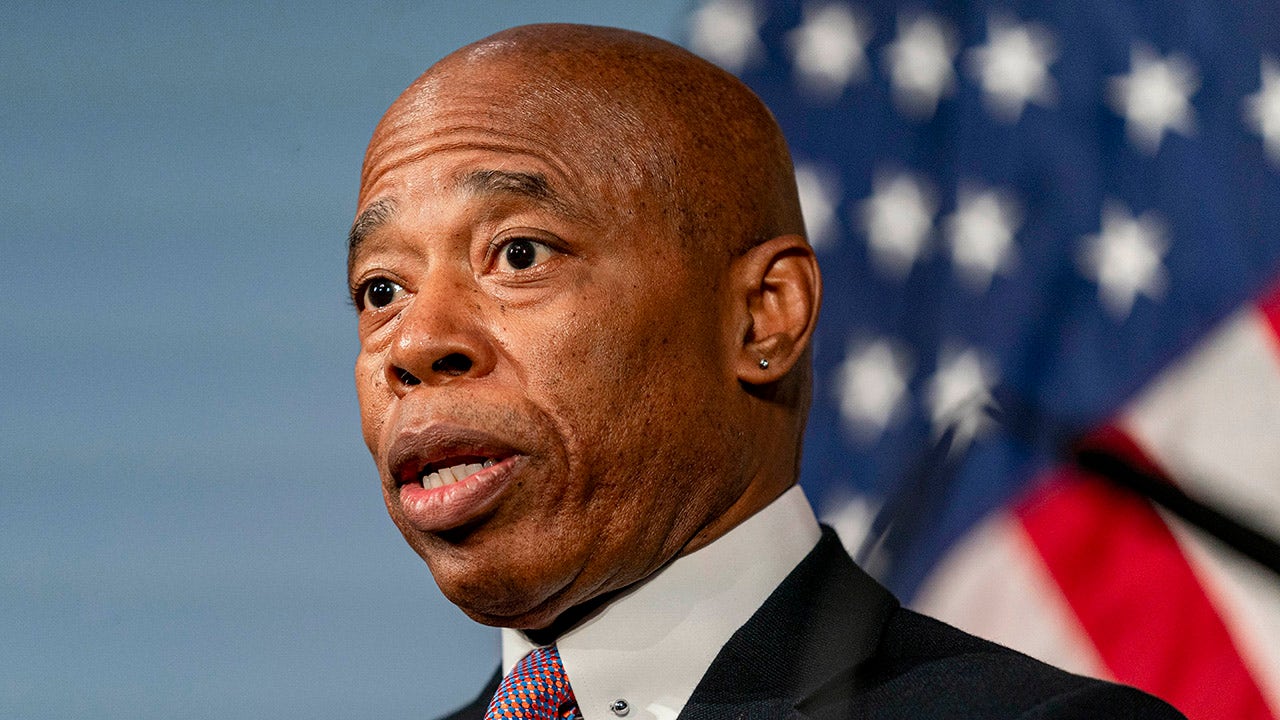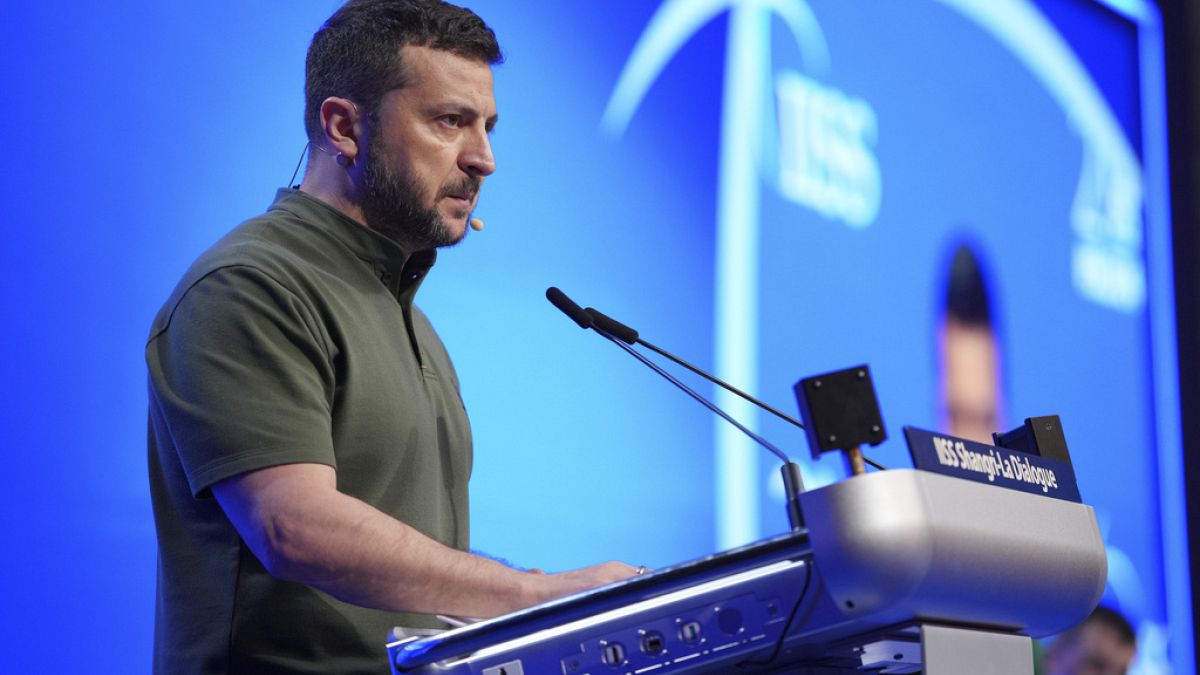South Dakota
New genus of tiny, hornless deer that roamed South Dakota 32 million years ago discovered

A new genus of tiny, hornless deer that lived in South Dakota during the Oligocene Epoch approximately 32 million years ago has been discovered by a team of researchers from Badlands National Park, the American Museum of Natural History and California State Polytechnic University, officials said.
The new deer, called Santuccimeryx, meaning “Santucci’s ruminant”, was named after Vincent L. Santucci, the Senior Paleontologist and Paleontology Program Coordinator in the Geologic Resources Division of the National Park Service “to honor his history with and advocacy for the paleontology program at Badlands National Park,” according to a statement from the National Park Service announcing the discovery.
A high definition photo of the Santuccimeryx skull discovered at Badlands National Park in 2016.
National Park Service
The research was published this week in the “Proceedings of the South Dakota Academy of Science.”
“Santuccimeryx belongs to the extinct family Leptomerycidae, and its skull shares features of both the Oligocene genus Leptomeryx and the Miocene genus Pseudoparablastomeryx, two animals that are nearly 10 million years apart in time,” NPS said in their statement. “The family Leptomerycidae were about the size of house cats and lived in North America from the late-middle Eocene (about 41 million years ago) to the end of the middle Miocene (about 11 million years ago). They are considered close relatives to the living chevrotains, or mouse deer, from the tropical forests of central and western Africa and southeast Asia.”
The new genus of deer has teeth very similar to Leptomeryx and a skull resembling that of the Pseudoparablastomeryx, officials said.
“Since it does not fit into either existing genus, [officials] concluded the deer must be placed into a new genus of its own,” NPS said.

A paleoartistic reconstruction of the newly named genus Santuccimeryx elissae, shown standing in front of hackberry bushes. Its small size (3-5 lbs), relatively large orbits, and shortened skull differentiate Santuccimeryx from the tiny Oligocene deer Leptomeryx. Illustration by Benji Paysnoe.
Illustration by Benji Paysnoe.
“I am both personally and professionally grateful to be associated with this important new fossil discovery from Badlands National Park, where I began my career as a paleontologist with the National Park Service in 1985,” Santucci said.
The research was prompted when the first — and still only known skull of the deer — was discovered at Badlands in 2016.
“It’s a really neat example with this paper to be able to highlight citizen science, because this is the only skull of this animal ever found,” Mattison Shreero, who headed up the research, said. “And if somebody had walked away with it, or if they just hadn’t reported it and it had eroded away, we would have never known about it.”
Visitors at Badlands who spot what they think might be a fossil or artifact are asked to leave it in place and submit a Visitor Site Report at the Visitor Center, with a park ranger, or by email information about their find to Badlands_fossil_finds@nps.gov.

South Dakota
By hand or machine: Tabulator bans go to voters in three counties Tuesday • South Dakota Searchlight

On Tuesday, when voters in three counties decide whether to ban tabulator machines in future elections, it will be the culmination of a statewide citizen group’s multi-year movement to switch South Dakota elections to hand counting.
The votes – in Gregory, Haakon and Tripp counties – were forced by citizen-initiated petitions. Proponents of the ban claim that tabulator machines lack transparency, that election officials are breaking a state law that dictates where ballots can be counted, and that hand counting ballots is cheaper than machine counting. County auditors — the elected officials who oversee local elections — say machine counting is accurate, transparent and more efficient, and they worry a switch to hand counting could be more expensive.
Whatever the outcome, members of the South Dakota Canvassing Group plan to continue their push for hand counting.
“There’s a fire going here and will not be going out soon,” said Steve McCance, one of the lead petitioners for the Gregory County ballot question.
The nonprofit organization is part of a nationwide movement that started after the 2020 election, motivated in part by claims that the election was “stolen” from former president Donald Trump. Trump filed more than 60 lawsuits contesting either the election or the way it was administered. None of the cases succeeded, and he’s currently under criminal prosecution for allegedly attempting to subvert the election.
Polling by South Dakota News Watch and the Chiesman Center for Democracy shows that 67% of South Dakota voters accept the outcome of the 2020 presidential election, but only 20% are “very confident” that American election results reflect the will of the people.
Robert Tate, one of Tripp County’s lead petitioners, said it’s important that Americans have confidence in elections.
“If we elect an elected official and he’s not doing a good job, then we complain about him for four years and then we can vote him out,” Tate said. “But if we don’t have confidence in our elections and then our governor or our president isn’t doing a good job, we complain about how they stole the election. We don’t want that. That’s not good. ”
Several tabulator ban petitions were circulated at the county level across the state earlier this year, with some counties — including Lawrence, McPherson and Charles Mix counties — rejecting them. Officials in some counties said the petitions could conflict with federal election requirements, according to their legal counsel.
Push for hand counting focused on transparency
Aside from concerns about accuracy, South Dakota Canvassing President Jessica Pollema said the group is dedicated to transparency.
“The elections belong to the people, but they’ve been contracted out to a third party that’s blacked out an audit trail. People don’t trust that,” Pollema said. “Once there’s full transparency, people will possibly be able to trust the system again.”

South Dakota county auditors contract with Election Systems and Software, known as ES&S, a national company based in Omaha, to lease and operate tabulator machines. The company “doesn’t sign an oath,” Pollema said, and the group’s members have not been able to audit the system themselves through public records requests.
Tate said he and other members of South Dakota Canvassing asked for cast vote records and were told they “did not exist.” Activists nationwide requested such records.
A cast vote record is the electronic representation of how a voter voted (without personally identifying information), which is not a public record in the state and is only able to be produced with certain software in a few counties, officials said.
Will Adler is the associate director of the Elections Project with the Bipartisan Policy Center, which advocates for election policy reform approved by a task force of election officials aiming to make elections more secure, fair and trustworthy.
Adler said allowing cast vote records and images of marked ballots to be public records would “improve transparency a lot.” Two bills introduced during the 2024 legislative session that would have made cast vote records public — one introduced by the Secretary of State’s Office and one by Sen. Tom Piscke, R-Dell Rapids — failed to pass out of committee.
“In general, that’s a more promising avenue to move towards that would allow members of the public to understand why they can trust the tabulations,” Adler said.
State law allows for several forms of transparency in elections, including the use of poll watchers to observe the election process and public test runs of tabulators before each election to check for accuracy. Petitioners in Tripp County held a hand counting seminar the same day as the county’s tabulator test on May 30.

In 2023, the South Dakota Legislature addressed transparency by passing a bill to require post-election audits. County auditors must randomly audit at least 5% of ballots cast in voting precincts after the primary and general elections. South Dakota was one of the last few states to implement audits.
Some counties have decided to audit more than the required 5% after the primary, including Tripp, Haakon and Gregory counties.
Adler said post-election audits are a step in the right direction, though he said some other states are implementing “risk limiting audits,” which can change the audit amount based on the closeness of the race.
“This allows you to have really high confidence in a really efficient way and leveraging that human insight,” Adler said. “That allows you to have quick tabulation and quick comprehensive audits.”
Petitioners, auditors differ on cost estimates
In Haakon County, Auditor Stacy Pinney and the county state’s attorney estimates hand counting could cost more.
“I plan and prepare for the worst, but I work for the best outcome,” Pinney said.
The worst case scenario, for Pinney, is that it could take up to 15 hours for paid election workers to count the ballots, making mistakes and having to recount. County commissioners set election worker rates at the beginning of an election year. Precinct workers are required to be paid, according to state law.
The three county auditors’ estimated budgets for machine counting vs. hand counting vary, depending on how long it could take workers to count ballots. At their quickest possible pace, hand counting would be cheapest, though auditors don’t expect that.
“Honestly, we know it would never take just an hour,” said Tripp County Auditor Barb DeSersa. “Some precincts are larger than others, so it’s hard to judge how many hours it would take. It also depends on the voter turnout.”
South Dakota implemented machine tabulators in the early 2000s. Mark Nelson, one of the lead petitioners in Haakon County, was an election worker over 40 years ago and said hand counting back then “wasn’t that difficult.”
But even if it is more expensive to hand count, that money stays within the county by paying residents rather than an out-of-state corporation, said South Dakota Canvassing’s Pollema.
Pollema said hand counting can be cheaper, especially if using a specific kind of tally sheet that her group has determined can be used to count 250 ballots per hour with up to 11 races on one ballot with a trained team.
Adler said that even if auditors used the tally sheet South Dakota Canvassing Group is proposing, hand counting could still have a higher risk of error and costs.
“Regardless of how you implement it, the fact is humans are extremely bad at repetitive tasks like counting ballots,” Adler said, referencing studies on human error in different industries. “I think there’s just no way around it.”
Tripp County hand counted ballots for the 2022 election. DeSersa was awake for 40 hours straight between Election Day and the day after, with a significant amount of that time supervising hand-counters. Several races had to be recounted, sometimes three or four times that night.
Group alleges elected officials breaking law
Pollema and petitioners also claim that ballots must be counted within the precinct boundaries where they were cast, and doing otherwise is unlawful. But that statute only refers to hand counting ballots, not tabulating, said Sara Frankenstein, a Rapid City lawyer who specializes in election law.

“With the advent of automatic tabulating systems, we have a chapter in our South Dakota code that governs when those machines are used,” Frankenstein said, referencing a statute regarding the auditor setting up a central counting location (which is usually the courthouse or the county administration building) and keeping the process open to the public.
Frankenstein said the allegations are “reckless.”
“Ballots absolutely can and are required to be taken to the central location the county auditor deems,” Frankenstein said, referring to elections that include tabulator machines. “So they aren’t doing anything illegal by following those very laws.”
Whether the bans pass or not, South Dakota Canvassing will continue pushing for hand-counted elections, attending state Board of Elections meetings and supporting legislative efforts that align with their values, Pollema said.
“The people need to have the government under their watchful eye. That’s why we’re in this mess,” Pollema said. “We’ve been a little apathetic to our approach of watching our government. Now the people realize what’s going on and have decided to participate at all levels.”
GET THE MORNING HEADLINES DELIVERED TO YOUR INBOX
South Dakota
3 South Dakota counties to vote on returning to ballot tabulation by hand

Voters in at least three rural South Dakota counties are set to decide Tuesday whether to return to counting ballots by hand, the latest communities around the country to consider ditching machine tabulators based on unfounded conspiracy theories stemming from the 2020 presidential election.
The three counties, each with fewer than 6,000 residents, would be among the first in the U.S. to require old-school hand counts, which long ago were replaced by ballot tabulators in most of the country.
A number of other states and local governments have considered banning machine counting since the 2020 election, but most of those efforts have sputtered over concerns of cost, the time it takes to count by hand and the difficulty of hiring more staff to do it.
‘ELECTION INTERFERENCE’ CLAIMS MUDDY BATTLEGROUND STATE POLITICS AMID COMPETITIVE RACES
Experts say counting the votes by hand is less accurate that machine tabulation.
Supporters of the South Dakota effort aren’t deterred by such worries.
“We believe that a decentralized approach to the elections is much more secure, much more transparent, and that the citizens should have oversight over their elections,” said Jessica Pollema, president of SD Canvassing, a citizen group supporting the change.
Like efforts elsewhere, the South Dakota push for hand counting has its origins in false claims pushed by former President Donald Trump and his allies after the 2020 presidential election. They made claims of widespread voter fraud and spread conspiracy theories that voting machines were manipulated to steal the election. There has been no evidence to support such claims, but they have become embedded in many places that voted heavily for Trump.
The citizen initiatives in South Dakota to prohibit tabulating machines are set to appear on Tuesday’s primary ballot in Gregory, Haakon and Tripp counties. Similar petition efforts for future measure votes are underway in more than 40 other counties in the conservative state, Pollema said. At least four counties have rejected attempts to force hand counting.
Earlier, the Fall River County Commission voted in February to count ballots by hand for the June election, and Tripp County counted its general election ballots by hand in 2022.
From left, Jessica Pollema speaks Oct. 19, 2023, at the Military Heritage Alliance in Sioux Falls, S.D. She is a co-founder of South Dakota Canvassing and a leading advocate of getting rid of the machines in favor of hand counting ballots in South Dakota. (Stu Whitney/South Dakota News Watch via AP)
If the measure passes Tuesday, Gregory County Auditor Julie Bartling said the county will have to increase the number of precincts to lessen the burden of hand counting. That will force it to buy more assisted voting devices for disabled voters. The county also will face the difficult task of hiring more election workers.
Bartling, who runs elections in the county, opposes the initiative and said she has “full faith in the automated tabulators.”
Todd and Tripp County Auditor Barb DeSersa said she also opposes attempts to require hand counting of all ballots because the process isn’t as accurate. She said the 2022 hand count left election workers exhausted.
“I know the ones that have done it the last time didn’t want nothing to do with it this time, so I think once they do it once or twice, they’ll get tired of it, and it’ll be harder to find people to volunteer to do that,” DeSersa said.
DeSersa’s office estimated it would cost $17,000 to $25,000 for elections in Tripp County to be counted by hand, compared to about $19,000 to $21,000 using tabulators. Haakon County Auditor Stacy Pinney said she initially estimated hand counting will cost between $750 and $4,500, but “overall, an election cost is hard to determine at this point.”
According to a state attorney’s analysis for Haakon County, it would take two election workers using a tabulator three to four hours to count all the ballots. It would take 15 to 20 election workers between five and 15 hours to do a hand count, depending on the number of contested races.
The three counties have a combined 7,725 active registered voters, according to a statewide report.
Republican state Rep. Rocky Blare, who lives in Tripp County, said he will vote against the measure.
“They can’t prove to me that there’s been any issues that I think have affected our election in South Dakota,” Blare said.
Secretary of State Monae Johnson, a Republican, expressed confidence in tabulating machines, noting they have been used for years. In a statement, she pointed to “safeguards built in throughout the process and the post-election audit on the machines after the primary and general election to ensure they are working properly.”
The June election will be the first with a post-election audit, a process included in a 2023 state law. It involves hand counting all the votes in two races from 5% of precincts in every county to ensure the machine tabulation is accurate. Johnson’s office said there was no evidence of any widespread problems in 2020 or 2022. One person voted twice, she said, and was caught.
After repeated attacks against machine-counting of ballots in the 2020 presidential election, Dominion Voting Systems last year reached a $787 million settlement in a defamation case against Fox News over false claims the network repeatedly aired. The judge in that case found it was “CRYSTAL clear” none of the claims about Dominion’s machines was true, and testimony showed many Fox hosts quietly doubted the claims their network was airing.
Since 2020, only a few counties have made the switch to hand counting. In California, officials in Shasta County voted to get rid of their ballot tabulators, but state lawmakers later restricted hand counts to limited circumstances. Officials in Arizona’s Mohave County rejected a proposal to hand count ballots in 2023, citing the $1.1 million cost.
David Levine, a former local election official in Idaho who is now a senior fellow with the Alliance for Securing Democracy, said research has shown hand counting large numbers of ballots is more costly, less accurate and takes more time than machine tabulators.
“If you listen to conspiracy theorists and election skeptics throughout the U.S., one reason the 2020 election was illegitimate was because of an algorithm. Hence, if you take computers out of the voting process, you’ll have a more secure election,” Levine said. “The only problem: it’s not true.”
While some areas do count ballots by hand, mainly in the Northeast, it typically happens in places with a small number of registered voters. Hand counts are common during post-election tests to check that machines are counting ballots correctly, but only a small portion of the ballots are manually checked.
Election experts say it’s unrealistic to think workers in large jurisdictions, with tens or hundreds of thousands of voters, could count all their ballots by hand and report results quickly, especially since ballots often include multiple races.
CLICK HERE TO GET THE FOX NEWS APP
“The issue is that people aren’t very good at large, tedious, repetitive tasks like counting ballots, and computers are,” Levine said. “Those who believe otherwise are either unaware of this reality or choose to ignore it.”
South Dakota
Sioux Falls Eatery Earns 'Best Burrito in South Dakota' Honor

Who doesn’t love a delicious burrito? But where can you find the very best one in South Dakota?
As it turns out, the best burrito in the entire Mount Rushmore state can be found right here in Sioux Falls.
Travel website Far and Wide has compiled a list of the best burritos in every state and a signature Sioux Falls restaurant stands above the rest for the best burrito in South Dakota.
The Best Burritos in Sioux Falls
Here’s where Far and Wide says you can find, not only the best burrito in South Dakota but also, Iowa and Minnesota.
In South Dakota? The number one option for a burrito is Jacky’s. Jacky’s has 3 locations in Sioux Falls, and if you look at its impressive menu, you can see why this place is a fan favorite.
At Jacky’s, there are several different burritos to choose from: Breakfast Burritos, Dry Burritos, Wet Burritos, and even its famous Shrimp Burrito.
What About Our Neighbors?
Jackys Restaurant (via Facebook)
As for surrounding states, the number one option in the state of Iowa comes from Iowa City. There, you can find the best burrito in the Hawkeye state, at La Regia Taqueria.
In the state of Minnesota, the favorite place to grab a burrito is at the Maya Cuisine in Minneapolis.
For a look at all 50 states and to find the best burritos from coast to coast, see the article from Far and Wide here.
Story Source: Far and Wide
Story Source: Jacky’s Restaurant
10 South Dakota Myths Even Some Natives Believe
SO, to do our part in educating folks, here’s a list of some of the most ridiculous myths outsiders always believe South Dakota.
Gallery Credit: Andy Gott
-

 News1 week ago
News1 week agoRead the I.C.J. Ruling on Israel’s Rafah Offensive
-

 World1 week ago
World1 week agoHoping to pave pathway to peace, Norway to recognise Palestinian statehood
-

 News1 week ago
News1 week agoLegendary U.S. World War II submarine located 3,000 feet underwater off the Philippines
-

 World1 week ago
World1 week agoFamilies of Uvalde school shooting victims sue Microsoft, Meta and gunmaker
-

 Politics1 week ago
Politics1 week agoDefense Secretary Lloyd Austin to undergo nonsurgical procedure, Deputy Kathleen Hicks will assume control
-

 Politics1 week ago
Politics1 week agoHunter Biden attends pre-trial hearing in Delaware court on federal gun charges
-

 News1 week ago
News1 week agoHere are three possible outcomes in the Trump hush money trial : Consider This from NPR
-

 News1 week ago
News1 week agoPrimate remains on the loose in South Carolina | CNN



















